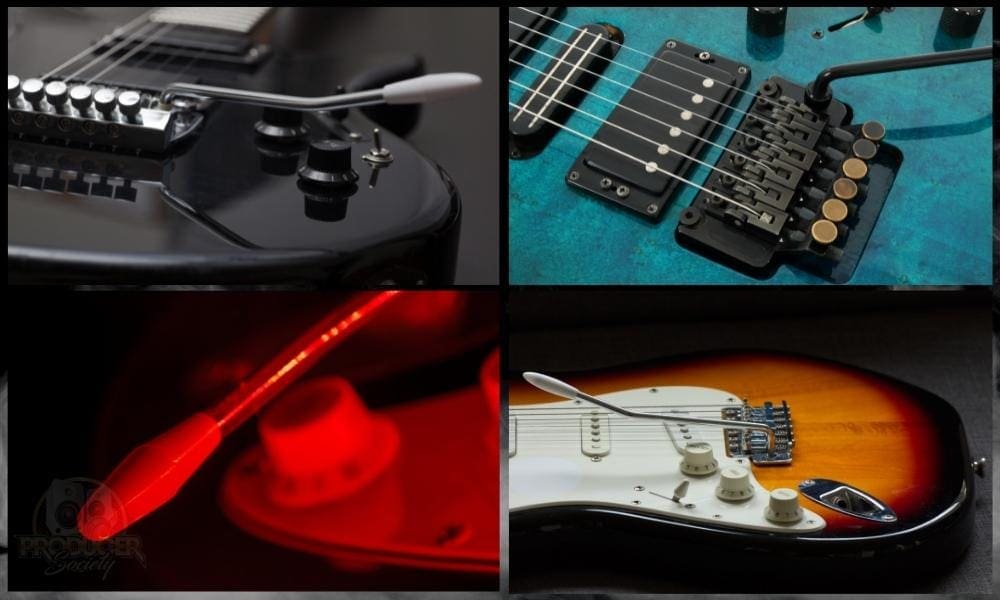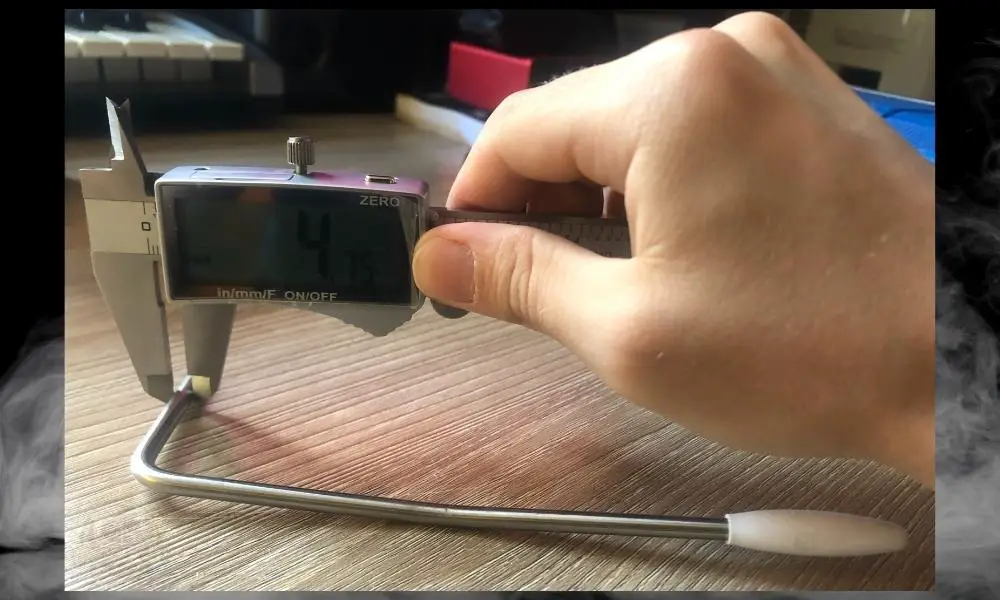Setting up a guitar properly, especially one that has a Floyd Rose or a vibrato-style bridge, can be a challenge. Once you start getting into specificity and all of the little tricks and tips that you can do, it can get even harder.
I’m not a guitar technician by trade either, however, I’ve learned a few things over the 15-20 years I’ve played guitar. Whammy bar stiffness is one thing I’ve had to deal with recently, and it turns out there are a few ways of approaching it.
The most commonly suggested way to fix a stiff whammy bar is to remove the back plate and loosen the screws atop the springs with a 1/4″ screwdriver. This presupposes it’s the vibrato that’s too tight. If the bar is too stiff, loosen the tremolo arm screw with an Allen wrench or screwdriver.
Semantics is a bit of an issue here because when people say their bar is too stiff, they could be referring to either the bar itself or the bridge and the springs in the back of the guitar. For this reason, we’re going to explore the solutions for each, that way everyone who’s having either problem gets both answered. Anyway, let’s dive in below.
4 Ways to Fix A Whammy Bar That’s Too Stiff
![Whammy Bar Stiffness - How to Fix A Whammy Bar That's Too Stiff [SIMPLE]](https://travelingguitarist.com/wp-content/uploads/2022/06/Whammy-Bar-Stiffness-How-to-Fix-A-Whammy-Bar-Thats-Too-Stiff-SIMPLE-.jpg)
As I was saying a moment ago, there are two problems: one is that it’s the bar that is the issue, while the other is that it’s the springs in the back.
Both are separate solutions for different problems. The first thing we’re going to do is approach the bar issue. After that, we’ll approach it from the bridge angle instead.
1) Loosen the Tremolo Arm Screw For More Play
![Adjustable Tensioner on Whammy/Tremolo - Are Whammy Bars Supposed To Be Loose? [ANSWERED]](https://travelingguitarist.com/wp-content/uploads/2022/06/Adjustable-Tensioner-on-WhammyTremolo-Are-Whammy-Bars-Supposed-To-Be-Loose-ANSWERED.jpg)
Assuming, as I said, that your bar is too loose and it isn’t a problem with your bridge and how your tremolo system is set up, it’s very possible there is no lee-way in your whammy bar because of the tremolo arm screw.
I talked about this already in my guide on how loose whammy bars are supposed to be, and in that guide, I explained how you just need a 1.5mm Allen wrench or a 1/16″ Allen wrench to adjust that screw which is pointed out in the image above.
Of course, you would turn it counter-clockwise to loosen the tension on the bar, effectively making the bar a little less tight in the hole.
That said, different guitar manufacturers use different measurements, so you may have to look up your brand online to find out what tools you actually need. I know guitars with Floyd Roses, for example, often have this very same tremolo arm adjustment tool.
On some Fender guitars, the whammy bar is actually threaded into the tremolo armhole so you have to turn it until it comes out. In this case, you’ll have to just turn it a bit counter-clockwise to loosen it if it’s too stiff on account of being wound too tight.
2) Buy A Properly Sized Tremolo Arm/Whammy Bar

From what I’ve seen thus far, Amazon has the best selection of Whammy Bars so I would recommend going there first. While many of them are not name-branded which I’m a bit annoyed by, Amazon has the largest selection in terms of thickness and diameter.

Using the proper thickness whammy bar on your guitar will ensure that your bar doesn’t move around in the tremolo hole, which is incredibly annoying, unpleasant, and just not fun to play with if you like to use the whammy a lot.

Related to what I was saying before with whammy bars having threads on them, it’s doubly important you get the whammy bar size right if there is a thread on it. So keep that in mind.
In most cases though, the whammy bar isn’t really the issue, it’s how much tension is set on the strings in the back of the guitar, which I’ll show you how to fix now.
3) Loosen the Springs in the Back of the Guitar
![Springs - How to Fix A Whammy Bar That's Too Stiff [SIMPLE]](https://travelingguitarist.com/wp-content/uploads/2022/06/Springs-How-to-Fix-A-Whammy-Bar-Thats-Too-Stiff-SIMPLE.jpg)
This fix presupposes the issue with your tremolo and your bridge has to do with the springs in the back of your guitar, and not the bar, itself. There are many different ways of approaching the spring issue and a bit of debate and the proper way of doing it.
For instance, this video from Guitar World has the Supertramp guitarist, Carl Verheyen, explaining how he likes to have 3 springs in the back, with specifically more tension on the lower strings instead of the higher strings.
![Still of Carl Verheyen - 3 Springs - How to Fix A Whammy Bar That's Too Stiff [SIMPLE]](https://travelingguitarist.com/wp-content/uploads/2022/06/Still-of-Carl-Verheyen-3-Springs-How-to-Fix-A-Whammy-Bar-Thats-Too-Stiff-SIMPLE.jpg)
The reason for this is pretty fascinating: it’s that it allows him to easily pull up on the whammy bar to raise the pitch of notes, essentially making the whammy much easier to use for all kinds of techniques, particularly those on higher-pitched and thinner strings.
The way Carl Verheyen does it isn’t the only way people like to set up the springs on the back of the guitar. Some people prefer to have just 3 springs with equal tension, instead of 5 because they say it offers balanced tension on each side of the guitar neck.
This seems to be a really common way of doing it that a lot of people like to use, although, as I’ve said earlier, I’ve never really had a problem with my PRS going out of tune, nor have I had a problem with the bridge that necessitated me taking the back cover off.
The video down below is very helpful for not only the whammy bar and tremolo system set-up, but also for his comments on Eric Johnson.
Another cool point to make – albeit slightly unrelated – is the fact that you can take the back cover off the guitar for the guitar to sound “better.” People like Eric Johnson, the master of the Fender Strat, state that the guitar sounds better without the backplate.
But I digress, let’s talk about the last solution on the list which has to do with the actual mechanics of your tremolo system. It’s possible you may need to just lube things up a bit to get it working as it should.
I left this solution for last because usually, this isn’t the problem but it can be at times, especially if you’re using an older guitar.
4) Use A PTFE Lubricant For Cleaning Up An Uneasy Tremolo System

If your tremolo system isn’t as smooth as it should be or it’s a little stiff in places where it shouldn’t be, another solution is to use a PTFE spray or lubricant like the WD-40 PTFE spray.
It’s important not to use regular WD-40 because it’ll grease everything up and attract a lot of dust.
This method, however, is better served when you’re running into tuning stability issues after having depressed the bar a bit or raised it. If tuning instability is the name of the game, that’s a whole other issue on its own.
How Do You Make A Whammy Bar Easier?
In simple terms, to make a whammy bar easier to use, take the back cover off of the guitar, and then use a 1/4″ screwdriver on the claw attached to the springs. Loosen the screws counter-clockwise to bring the claw toward the springs, essentially loosening them and taking tension off the tremolo.
How Tight Should Your Whammy Bar Be?
As I said in my guide on the looseness of whammy bars, how tight your whammy bar should depend mostly on personal preference.
However, most guitarists prefer to have their whammy bar set up in such a way that it’s not so tight that you can’t move it, but also not so loose that you lose all tuning stability and the whammy bar just flops around.
Other Articles You May Be Interested In
- How Tight Should Guitar Strings Be?
- Can A Whammy Bar Break Strings? [ANSWERED]
- What’s the Difference Between A Whammy and Tremolo Bar?
- Are Whammy Bars Supposed To Be Loose? [ANSWERED]
- Whammy Pedal vs Whammy Bar – What’s the Difference? [EASY]
How Do You Make A Tremolo Looser?
In most cases, a tremolo that is too tight is because the claw is being pulled really hard on the back of the guitar by the springs. In other words, the springs are tightened far too much, causing there to be quite a bit of tension on the back springs.
To relieve some of the tension on the back springs of the guitar, use a 1/4″ screwdriver to loosen the screws on the back, that way the claw is brought forward toward the springs a bit, and thus tension is removed from the springs.
Important Things to Note About Whammy Bar Stiffness
1) There Could Be Other Solutions
I’m not a guitar technician, but I believe I’ve covered the most common solutions for how to fix an overly stiff whammy bar or tremolo system on your guitar.
In the future, I’ll be sure to create an article on how to set up a floating Floyd Rose system, because I believe such an article would really do this topic justice.


 Written By :
Written By :
